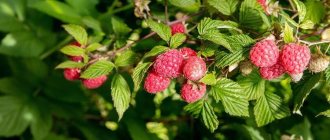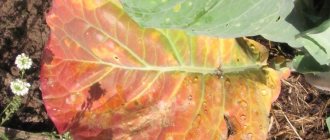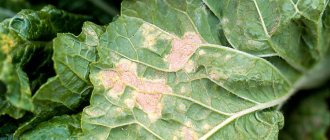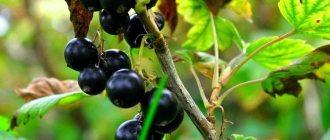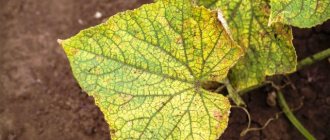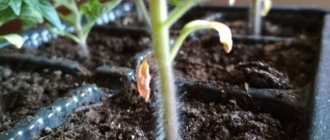Very often, gardeners grow vegetables such as pumpkin on their plots. It has a long growing season, which can reach up to 150 days. For the formation and ripening of fruits, a large amount of nutrients is required, which must be contained in the soil. Therefore, this vegetable needs to be fertilized regularly. There are many reasons why pumpkins have yellow leaves, one of them is the lack of useful elements. Yellowing of leaves can also be caused by various diseases and pests, unfavorable weather conditions, improper planting and many others.
Yellow leaves on pumpkin: reasons
Pumpkins are mostly grown either from seeds or from seedlings, depending on the weather conditions in your region. In the northern regions, pumpkins are planted only as seedlings; in the southern regions, they use both seeds sown in the ground and seedlings. If planting is incorrect and pre-sowing preparation conditions are not followed, yellow leaves may appear on the pumpkin. Dealing with this problem is not difficult. You just need to find out the cause in time and take measures to eliminate it.
Pumpkin seedlings most often turn yellow from lack of light. For normal development, pumpkin seedlings need at least 10 hours of daylight. If there is not enough natural light, then fluorescent lamps are placed above the seedlings to increase the length of the day.
Preventive measures
As already mentioned, if the leaves of a pumpkin turn yellow, it means that the care rules were violated or the vegetable became ill.
Eliminating the problem is always difficult, and there is a risk of crop loss, so it is best to carry out prevention.
Preventive measures are aimed at creating conditions under which the risk of diseases and pests is minimized.
Agricultural techniques
- removal from the garden of plant residues in which pathogenic pathogens, fungi and insect larvae can survive over the winter and subsequently become active;
- changing the place where the pumpkin is planted, returning it to its original place only after 3-4 years;
- sowing seeds and seedlings in dry sunny weather in moist soil;
- regular loosening of row spacing, which reduces moisture evaporation and reduces the amount of watering, increases the penetration of air flows to the roots;
- pinching the stems, leaving up to 4 ovaries, forming a bush of 2 stems, which supports adequate nutrition of the entire plant.
Chemical and folk remedies
- carry out pre-sowing treatment of seeds; this can be done by soaking them in a weak solution of potassium permanganate before planting;
- twice during the growing season, the plantings are sprayed with Bordeaux mixture to prevent the occurrence of fungal infections;
- choose pest-resistant varieties;
- increase plant immunity by adding fertilizer complexes and organic matter;
- spray the plantings with infusions to repel pests (with garlic, onions, wood ash, tobacco);
- When primary signs of damage appear, they are treated with fungicidal and insecticidal agents.
Yellow leaves on a pumpkin: external weather conditions
Very often, the cause of yellow foliage in pumpkins is temperature fluctuations. For example, a sharp drop in temperature during the day to 10 degrees, a long daytime drought, which gives way to cold weather at night, or night frosts, which led to the freezing of the vegetable, after which its leaves and lashes that were on the ground turned yellow.
Of course, we cannot influence temperature changes in any way, but we can help the plant adapt to them.
Nutritional deficiency
One of the main causes of yellow leaves is a lack of nutrients. For good growth and development, pumpkins need nutrient-rich soil. It is from the soil that this vegetable receives most of its nutrients.
Pumpkin constantly needs feeding during its growth process. And in order for it not to fade, so that the leaves do not turn yellow, and the vegetable itself feels great, you need to apply fertilizer according to the following schedule:
The first time fertilizing with organic fertilizers is carried out when the first 5-6 true leaves appear.
The second time feeding is carried out before flowering begins. They are mainly fed with organic matter and mineral fertilizers containing potassium.
The third time during flowering. Potassium fertilizers are used.
Further, throughout the entire growth of the pumpkin, it needs to be fed 2-3 more times, with fertilizers containing elements such as potassium, calcium, and phosphorus.
The feeding schedule described above must be carried out without fail. If the soil in your region is poor and contains few nutrients, then the amount of fertilizing needs to be increased.
You can fertilize plants either at the root or carry out foliar fertilizing, the only thing you can do is spray the plants before flowering; after this, this type of fertilizing should be completely avoided.
Improper care
If the agricultural technology for cultivating the vegetable is followed, problems rarely arise: the leaves are usually green, which confirms the photosynthesis occurring in them, and the vegetable itself gives a good harvest.
If the leaves and ovaries of the pumpkin turn yellow and dry, this is a signal of improper care.
Temperature
A sharp change in temperature, prolonged heat and prolonged cold spells equally affect the development of the plant, causing it severe stress. It does not matter in which direction the regime deviation occurred.
Unsuitable weather conditions are one of the main reasons why pumpkin leaves turn yellow.
- When cold weather sets in, the pumpkin foliage freezes, its edges dry out, and the leaves themselves turn yellow. The vegetable stops feeding, stops growing, the ovaries do not appear at all, or the ones formed do not form into fruits, but crumble.
- When it rises to 32° or more, pollination does not occur, the inflorescences dry out and fall off.
The seeds are sown after the threat of frost has passed and the soil has warmed up to a temperature of at least 12°C, optimally 15-18°C.
Agricultural technology
Compliance with agricultural technology when planting pumpkins is a condition for the proper development of the vegetable crop.
The basic rules suggest:
- pre-sowing seed treatment;
- regular weed removal;
- disinfection of soil and equipment;
- autumn digging of ridges;
- changing planting sites and choosing the right predecessors in accordance with crop rotation recommendations.
Watering
In the process of caring for planted pumpkins, gardeners often exceed the norms and frequency of watering.
Irrigation must correspond to weather conditions:
- abundant watering is required only during the onset of a hot period, while the plant is irrigated in the evening hours at the root, and during the period of solar activity, care is taken to ensure that water does not fall on the foliage; a suitable water temperature is 20-27 ° C;
- in cool climate regions, watering is reduced to a minimum, resorting to it only when the soil dries out.
Lack of nutrition and excess minerals
Poor care can destroy the plant
Due to the lack of some elements important for pumpkin development, the leaves dry out and fall off.
For full growth the following components are required:
Compensate for lack of nutrition with regular feeding. Minimum amount of fertilizer application:
- after planting seedlings in open soil or when seedlings planted by seed appear, 3-4 leaves;
- at the flowering stage;
- with the beginning of fruiting.
The exact opposite reason for the fall of the ovaries and drying out of the foliage is an excess of nutrients due to frequent feeding.
A hint for reducing the application of fertilizers will be excessively massive pumpkin vines and thick green mass. Most often, gardeners are faced with excess nitrogen.
Diseases
Pumpkin is a vegetable that is resistant to many diseases, but despite this, it can become infected from the soil or other plants. It is difficult to treat.
Diseases that can cause yellowing of foliage are mainly fungal in nature. Infection occurs in the soil, and first of all the roots are affected, and then the above-ground part. The disease quickly spreads throughout the plant. The source of infection is sometimes very difficult to detect.
Powdery mildew. A very serious illness. It will cut a wide variety of plants. A gray-white coating appears on the leaves, looking like flour. After some time, the coating becomes brown, and the whole plant turns yellow. The vines wither and dry out, the fruits do not form. The plant's immunity is greatly reduced. It is not able to fight, so it can become infected with other diseases or be attacked by insect pests.
Bacteriosis. The first sign of the disease is a slight yellowing of the leaves, which gradually turn brown. Dark spots appear on the back of the leaf, which gradually dry out. The fruits take on an irregular shape and become covered with spots.
White rot. At the beginning of the disease, the edges of the leaves begin to acquire a yellow tint. Then, after some time, the leaves become covered with a white coating, which becomes slimy. The process of rotting leaves begins, which gradually spreads to the entire plant.
Viral leaf mosaic. With this disease, the leaves turn yellow, become covered with yellow mosaic spots, curl and dry out. The fruits become deformed and also become stained. The plant itself grows very slowly as it is unable to absorb nutrients from the soil and additional fertilizing does not improve the situation. This disease mainly affects young pumpkin bushes.
Root rot. As a result of this disease, the roots of the plant rot. In this case, the above-ground part does not receive the nutrients necessary for normal development and begins to turn yellow. Yellowing begins with the lower leaves, then the lashes and gradually the whole plant becomes yellow.
What to do?
To prevent the harmful effects of abnormal temperature readings, plants are treated with antidepressants. Potassium humate can be considered the most harmless. For spraying, it is enough to dissolve 1 g of the drug in 10 liters of water.
If the temperature indicators are within the optimal range, and the ovaries on the melons fall off, then you should take care of feeding. They should be carried out both root-based, by watering with a nutrient solution under the root, and foliar, by spraying the buds with a solution of microelements using a spray bottle.
Root feeding
If nitrogen is needed for root feeding in the first stage of the growing season, now, during flowering and fruit set, the plant needs phosphorus and potassium. To prepare a nutrient solution, dissolve the following in a bucket of water:
- powdered superphosphate - 25-30 g;
- potassium sulfate - 10-12 g.
This nutrient solution is poured under each bush after abundant watering of the melon at the rate of 0.5 liters per root.
Fertilizing is carried out regularly, after watering with clean warm water, every 12-15 days.
Foliar feeding
During the period of pollination and formation of ovaries, it is advisable to treat melon vines with the following preparations:
- Boroplus - 20 ml per 10 liters of water;
- Maxicrol Ovary - 25 ml per 10 liters of water
Vegetable growers traditionally treat with boric acid with a 0.5% solution concentration. Boron has a very positive effect on the growth of generative organs, and when it is insufficient, the ovaries on melons fall off. This happens because if the element is insufficient, the process of photosynthesis, cell division, carbohydrate and protein metabolism is disrupted. This element is practically motionless. It does not pass from one plant system and organ to another. At the same time, young, growing organs need it most. Foliar feeding with boron preparations is carried out once every 5-7 days.
If it is noticed that not only the ovary crumbles, but the plant itself blooms very poorly, and the veins on the underside of the leaf are pink, then phosphorus deficiency is suspected. During this period, the best foliar feeding will be a solution of monocalcium phosphate or any liquid fertilizer with a high phosphorus content. The solution should be prepared according to the instructions for the fertilizer.
If the melon blooms poorly and the ovary behaves atypically, you need to examine the plant, analyze the growing conditions, watering, fertilizing and help the melon vines resume the processes of photosynthesis and fruit set.
Causes of diseases
1. Violations of agricultural technology, namely the irrigation regime. Too wet soil leads to root rot, especially if watered with cold water. Long periods of drought also have a negative impact.
It is better to water the soil infrequently, but abundantly, so that the water passes into the lower layers of the soil.
2. Crop rotation violations. If you plant a pumpkin in the same area constantly, this leads to depletion of the soil and the accumulation of fungi and pests in it. It is necessary to replant the vegetable to a new place every three years.
3. Not timely weeding and loosening of the area. All this leads to the rapid spread of the fungus throughout all plants.
Advice from experienced gardeners
Following the recommendations of experienced gardeners will help prevent yellowing and shedding of the ovaries:
- Pumpkin loves warmth and sun. For the garden bed, choose the sunniest place on the site.
- To water pumpkin bushes, use only warm water. Pour it at the root, trying not to get it on the flowers and leaves.
- After the pollination process is completed, the pumpkin bush is formed. Removing excess vines solves the problem of too many pumpkins forming.
- For large-fruited varieties, leave 2-3 canes per bush and 1 ovary on each cane. For small-fruited plants, it is enough to remove the vines without ovaries.
- Timely removal of weeds from the area will prevent the appearance of pests and diseases.
Yellow leaves on pumpkin: pests
Another cause of yellowing leaves is insect pests. The most common pumpkin pests are:
1. Melon aphid. Reproduces quickly. This insect is found on all organs of the plant, but most of all they can be found on the underside of the leaf. Aphids feed on the cell sap of the plant, as a result of which the leaves turn yellow, gradually weaken and fall off. It is difficult to completely destroy, since after treatments, adult plants die, but the larvae remain.
2. Spider mite. This pest weaves its web around leaves and stems. It also feeds on plant sap. Gradually the leaves turn yellow and fade. After a while they dry out and fall off.
On fruits, the negative impact of this insect results in cracking of the peel.
3. Slugs. These pests can be easily detected, but dealing with the damage they cause is difficult. They eat leaves, stems, and fruits of plants, as a result of which the leaves, lashes and stems turn yellow and wither.
Pest Control Methods
If pests appear, you should also treat the plant with chemicals and use folk remedies. To avoid the spread of spider mites, calendula can be planted around the pumpkin. It serves as an insect repellent.
Also, if the pests have already spread, you need to weed or fertilize the crop with onion infusion. To prepare it, take a bucket of water and add onions twisted in a meat grinder. You also need a spoonful of pepper, 3 tablespoons of ash and soap. All this needs to be mixed and processed.
Spraying is repeated once a week until the desired result is achieved.
To prevent the appearance of sprout flies, the vegetable crop should be treated with hydrogen peroxide during planting. When fighting melon aphids, fertilizing with phosphorus or potassium is used. Soap solutions or tinctures made from ash are also good.
A universal means of pest control is the Biotlinoma solution.
You need to get rid of aphids using pepper tincture. To do this, take a spoonful of soap, 3 tablespoons of ash and pepper twisted in a meat grinder. Next, add water and mix thoroughly. Spraying is repeated at intervals of 5 days, 2 times. They also use tincture of onion peels and decoctions of phytoncidal herbs.




